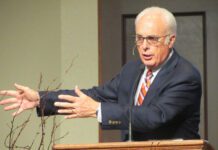The “sermon” is the epicenter of most Sunday morning church services. In seminaries around the world, pastors are taught how to construct and deliver a weekly monologue. It is often the only tool they are given to help God’s people learn, change and grow.
A few years ago, we came across a learning tool which (in our opinion) does away with the need for sermons. It’s called “Simply the Story,“ and it was designed as a way to help nonliterate cultures dig deep into God’s story and discover spiritual truths for themselves. Unlike sermons, everyone is involved. Everyone gets a chance to listen to the story, retell the story, explore the story and apply it to their own lives and context.
Here are 10 reasons we believe churches should stop using sermons and start using a technique like “Simply the Story” …
1. People aren’t good at listening. Research shows that people’s attention ebbs and flows during a sermon or lecture. At best, they have 10-15 minutes of sustained concentration for passive listening. Most sermons go well beyond this.
2. People learn more when they talk. People remember far more from a conversation they were involved in than a monologue they listened to. Dialogue “chunks” information into smaller segments and allows people time to process, think and ask questions when needed—helping them concentrate and stay engaged for longer.
3. People remember more. You start by listening to the story, then retelling it in your own words, then exploring it as a group, then applying it to your circumstances. This lays down a very strong memory of the story for years to come—something that rarely happens in a sermon.
4. People are more likely to pass it on. Exploring God’s story in this way empowers people to pass it on to their children, their neighbors and friends. They realize they don’t need a theological degree to understand and communicate God’s story to others.
5. Less preparation time than a sermon. The facilitator needs to take some time to memorize the Scripture passage and to study the context and background—but that is all they need to do. No hours of preparing, writing and rehearsing a well-polished speech. No need for dynamic public speaking skills and years of training.
6. More insights than a sermon. Everyone gets to share their “aha moments” and their perspective—not just one person. People get to discover spiritual truths by themselves, which has a greater impact than being “spoon fed” somebody else’s conclusions.
7. More relevance than a sermon. When a pastor prepares a sermon for a diverse congregation, he has to speak generically, not specifically to each person’s needs and context. When we come to God’s story together, we can apply the truths and principles directly to our own circumstances, both as individuals and as a community.
8. More authority than a sermon. A sermon is always about the pastor’s opinion and interpretation—the pastor is positioned as the “authority.” It is better for the combined community to go straight to the source, positioning God’s Word as the authority.
9. Less emphasis on the pastor. The system we use for church elevates the pastor above the rest of God’s people, and unintentionally sets him or her up as a mediator between God and His people. It is more powerful to give everyone the opportunity to access God’s Word directly, rather than just the “professionals.”
10. More room for the Holy Spirit to speak. Something special happens when God’s people gather together to seek His voice, His message, His will for the community. God often lays the same message on the hearts of a number of people, and a central theme becomes apparent throughout the meeting. Time and time again, we’ve seen the Holy Spirit speak through the most unlikely of people—which simply isn’t possible in the structure of a typical church service, where only one person is given a voice.
I’m not saying we have to do away with sermons altogether—but I am saying it might be nice to have more than one tool in the toolbox.













